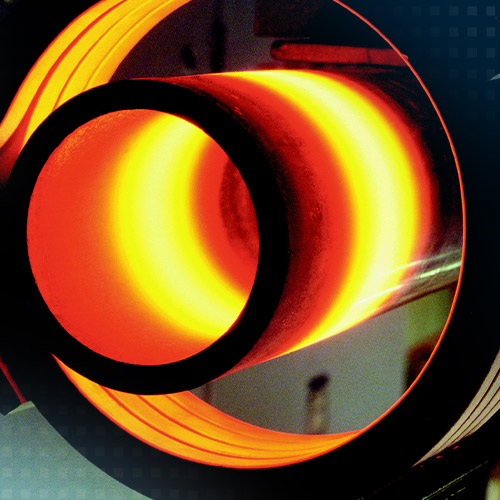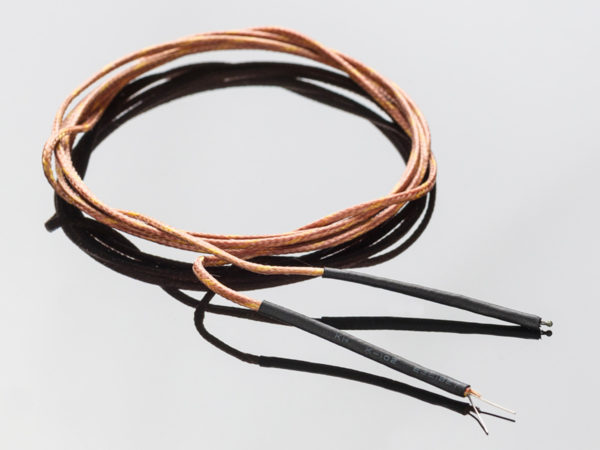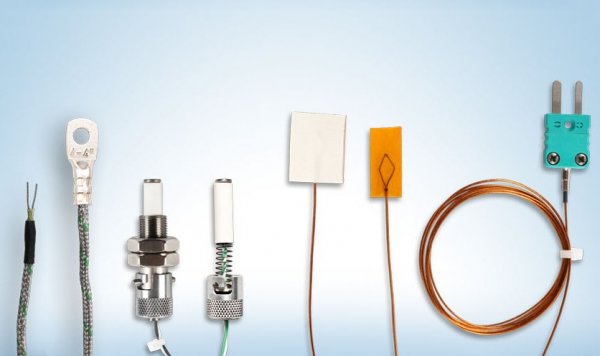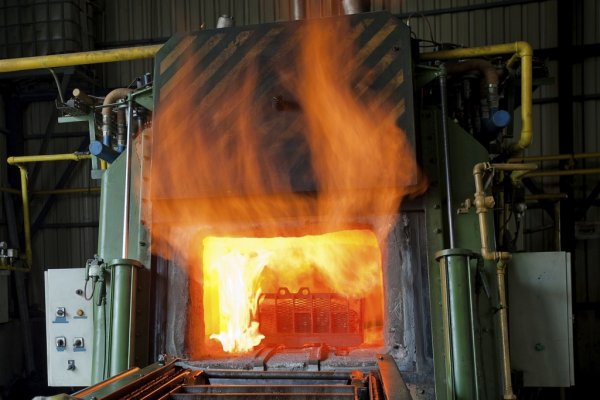Measurement of surface temperatures with thermocouples
Does not exist thermocouple of one typedesigned to measure the surface temperature of solid bodies (surface thermocouples). The abundance of existing surface thermocouple designs is primarily due to the variety of measurement conditions and properties of surfaces whose temperatures are to be measured.
In industrial practice, it is necessary to measure the temperatures of surfaces with different geometric shapes, fixed and rotating bodies, electrically conductive bodies and insulators, bodies with high and low thermal conductivity, smooth and rough. Therefore, surface thermocouples suitable for use in some conditions are unsuitable in others.
Measuring the temperature of a metal surface by welding a thermocouple
Quite often, to measure the temperatures of heated thin metal plates or solid bodies, a thermocouple junction is directly soldered or welded to the surface under test.This method of temperature measurement can only be considered acceptable if certain precautions are taken.
The heat exchange between the surface of the plate and the connecting ball of the thermocouples is mainly carried out by the heat flow passing through their contact surface, which is part of the surface of the junction and thermoelectrodes adjacent to the junction. To some extent, heat exchange occurs by radiation between the plate and the portion of the thermoelectrode junction surface that is not in contact with it.
On the other hand, the part of the junction surface in contact with the plate and the thermocouple thermoelectrodes lose thermal energy due to radiation to colder bodies surrounding the plate and convective heat transfer to the air flows washing the junction.
Thus, the junction and adjacent thermocouple thermoelectrodes dissipate a significant portion of the thermal energy that is continuously supplied to the junction through the plate contact surface.
As a result of the equilibrium, the temperature of the junction and the adjacent part of the surface of the plate turns out to be much lower than the temperature of the parts of the plate remote from the junction (when measuring high temperatures of thin plates, this systematic measurement error can reach hundreds of degrees) .
This error is reduced by reducing the amount of heat flux dissipated by the junction electrodes and thermocouple. For this purpose, it is useful to use thermocouples made from the thinnest thermoelectrodes possible.
The thermoelectrodes themselves should not be immediately removed from the plate, but it is better to first place them in thermal contact with the plate at a distance equal to at least 50 diameters of the thermoelectrodes.
It should be borne in mind that if the plate and the surface of the thermoelectrodes are not oxidized, they can be closed by the plate and measured thermoelectric power. etc. v. thermocouple will correspond to the temperature not of the thermocouple junction but to the temperature of the point of contact of the thermocouple with the surface.
In this case, a thin layer of electrical insulation, for example a thin sheet of mica, should be placed between the thermoelectrodes and the plate. It is also recommended to cover the entire surface of the junction and the thermoelectrode area with a layer of thermal insulation, for example a refractory coating, to reduce losses due to radiation and convective heat transfer.

By observing these precautions, it is possible to ensure that the surface temperature of metal parts is measured within a few degrees.
Sometimes it is not the connection of the thermocouple that is welded to the surface of the metal plate, but its thermocouples at some distance from each other.
This method of measuring the temperature of a metal surface can be considered acceptable only if there is confidence in the equality of the temperatures of the plates at the two points of welding of thermoelectrodes. Otherwise, parasitic thermoelectric power will appear in the thermocouple circuit. d. s developed from the thermoelectrode materials with the plate material.
Below is a description of thermocouples such as bow, patch, and bayonet.They are used to measure the temperatures of the surfaces of stationary bodies.

Thermocouple with bow (ribbon)
The nose thermocouple is equipped with a sensitive element made in the form of a strip made of two metals or alloys (for example, chromel and alumel) with a length of 300 mm, a width of 10 — 15 mm, soldered or welded in the forehead and rolled to a thickness of 0.1 — 0.2mm...
The ends of the band with a joint in the middle are fixed on insulators at the ends of a bow-shaped spring handle so that the band is taut at all times. From its ends to the terminals of the measuring device (millivoltmeter) there are wires made of the same materials as the two halves of the tape.
To measure the temperature of a convex surface, the beam thermocouple is pressed against that surface from the middle part so that the surface is covered with tape, at least for 30 mm sections on either side of the junction.
Pig thermocouple
The thermoelectrodes forming a thermocouple are soldered into the through holes of the red-copper disc. To ensure the mechanical strength of the structure, thermoelectrodes with a diameter of 2 — 3 mm are used. The lower surface of the disk (the "patch") is molded into the surface for which the thermocouple is intended to measure the temperature.
The thermoelectromotive force of the patch thermocouple is formed as a result of the closure of the thermoelectrodes by the metal of the patch. In good soldering, this closure occurs over the entire surface of the thermoelectrode segments recessed inside the patch.But the electrical circuit with the lowest resistance is mainly formed by the upper surface layer of the patch, and the temperature of this layer mainly determines the thermoelectric power. etc. v. thermocouples.
The heat balance equations of the patch thermocouple are similar to what was done above for the strip thermocouple, with the difference that in addition to the heat flux dissipated as a result of convective and radiative heat transfer from the outer surface of the patch, of great importance is to take into account the part of the dissipated heat flux sucked by the thermoelectrode patches due to their thermal conductivity.
It is necessary to take into account the following circumstance. Thermoelectrodes are made of different metals or alloys with different values of the coefficient of thermal conductivity. Thus, for example, the platinum-rhodium thermocouple thermocouple of the PP type is characterized by a coefficient of thermal conductivity that is half that of the second thermocouple - platinum.
If the diameters of the thermoelectrodes are the same, then the difference in the values of the thermal conductivity coefficients of the thermoelectrodes will lead to the fact that a temperature difference is formed in the places of electrical contact of the thermoelectrodes with the patch, which will lead to the appearance of parasitic thermoelectric energy in the thermocouple circuit . etc. with
Pin thermocouple
Thermocouples of this type are primarily used to measure the surface temperatures of relatively soft metals and alloys. For a bayonet thermocouple, thermoelectrodes made of sufficiently hard alloys, for example chromel and alumel with a diameter of 3-5 mm, are used.
One of the thermocouple thermoelectrodes is fixed fixedly on the head, and the second can move on its axis, and in the non-working state, its end is pulled by a spring under the end of the first thermoelectrode. The ends of the two thermoelectrodes are pointed.
When a thermocouple is brought to an object of considerable size, the surface of the object first touches the tip of the movable thermoelectrode. With additional pressure on the head, the thermoelectrode enters it until the tip of the thermoelectrode meets the surface of the object. Both points then pierce the surface oxide film on the surface of the object and this metal closes the electrical circuit of the thermocouple.
With good sharpening of the ends of the thermoelectrodes, the thermocouple gives reliable results for measuring the temperatures of the surfaces of non-ferrous metals with a soft, easily pierced oxide film.
The use of a bayonet thermocouple with blunt tips leads to the fact that the contact surfaces of the two thermoelectrodes with the object become relatively large, as a result of which the surfaces of the objects cool in the places where the ends of the thermocouples touch and the thermocouple gives clearly underestimated temperature readings. However, already after 20 — 30 seconds, the heat coming from the surrounding areas of the object heats up the cooled section, and with it the ends of the thermoelectrodes.
Thus, a bayonet thermocouple with blunt ends at the moment of contact gives underestimated readings of the temperature of the object, after which, within a few tens of seconds, its readings increase, asymptotically approaching a stable value.This stable value differs more from the actual value of the surface temperature of the object, the greater the contact surface of the blunt ends of the thermoelectrodes with the object.
Calibration of surface thermocouples
The stationary temperature of the surface thermocouple is lower than the measured temperature of the surface with which the thermocouple is in contact. This temperature difference can be largely accounted for due to the calibration of the surface thermocouple under heat transfer conditions from its outer surface, approaching operating conditions.
From this position, it follows that the calibration characteristic of thermocouple surfaces can differ significantly from the characteristic of a thermocouple formed by the same thermoelectrodes, but calibrated by the method of comparison with an example, when they are simultaneously immersed in a thermostated space.
Therefore, surface thermocouples cannot be calibrated by immersion in thermostats (liquid laboratory heating thermostats for calibrating thermocouples). A different calibration technique must be applied to them.
Surface thermocouples are calibrated by applying the required pressure to the outer metal surface of the thin-walled liquid thermostat. The heated liquid inside the thermostat is mixed well and its temperature is measured with some sample device.
The outer surface of the thermostat is covered with a layer of thermal insulation. The thermal insulation does not cover only a small area of the outer surface, which is approximately half the height of the thermostat, on which the thermocouple is applied.
In this design, the temperature of the metal surface of the thermostat below the surface thermocouple, with an error not exceeding a few tenths of a degree, can be considered equal to the temperature of the liquid in the thermostat.


